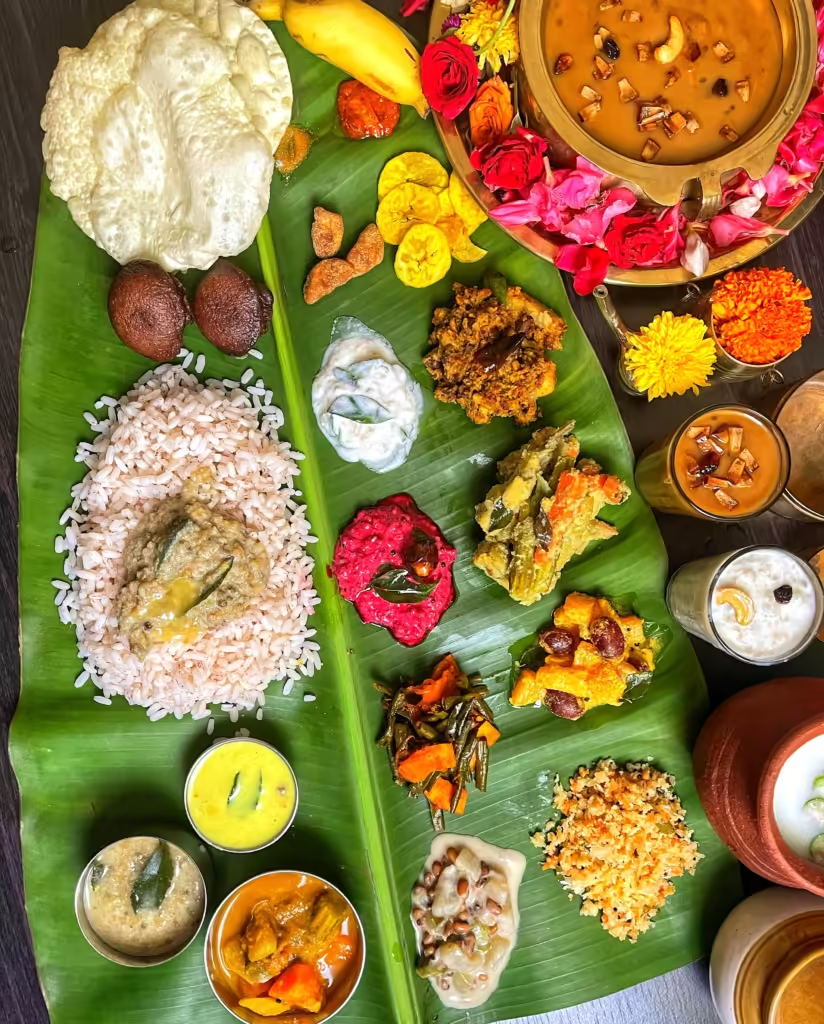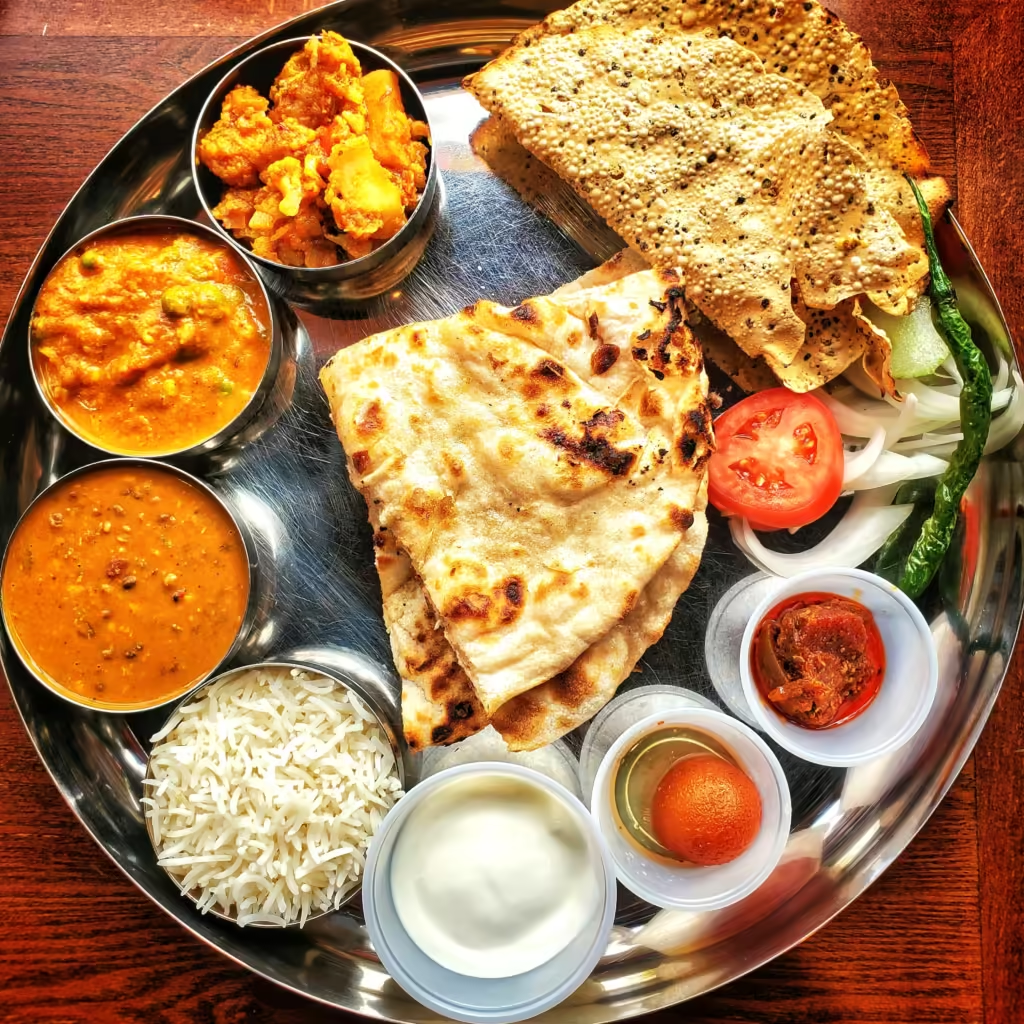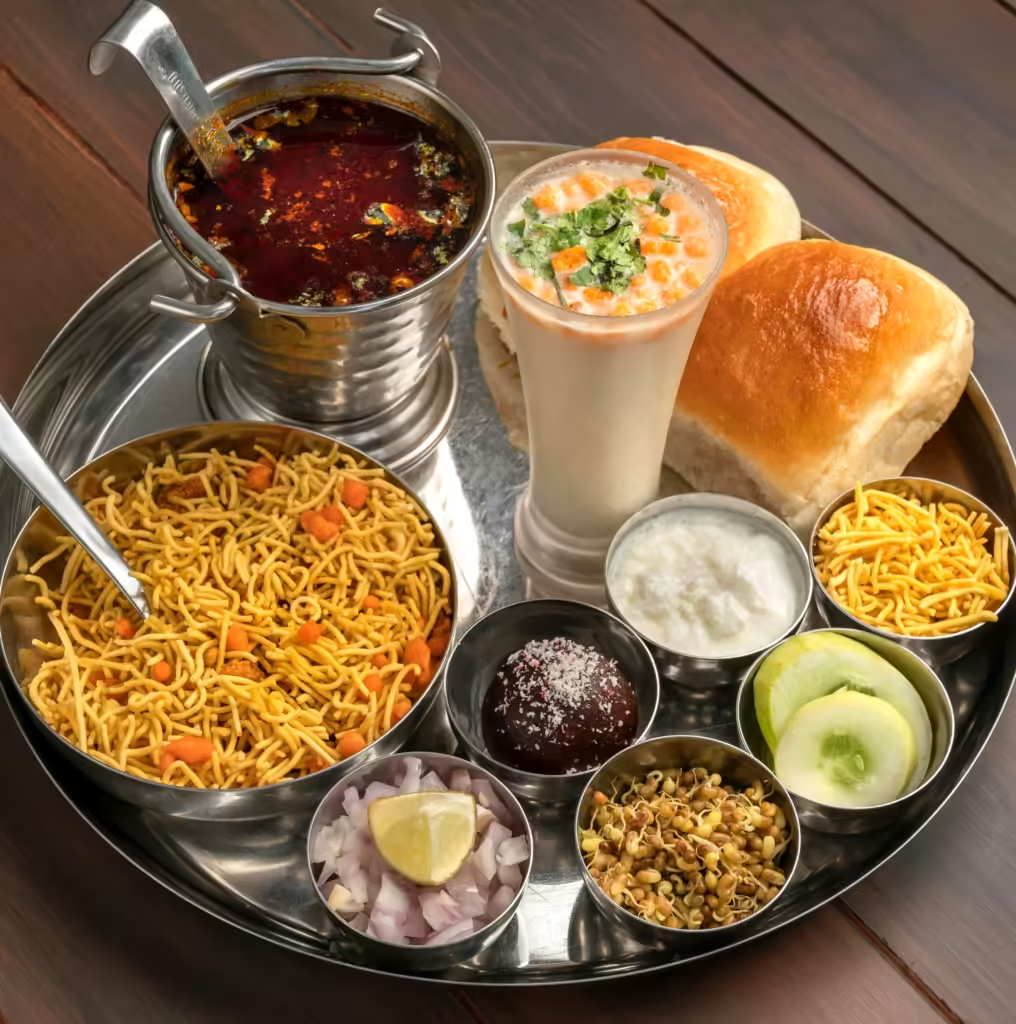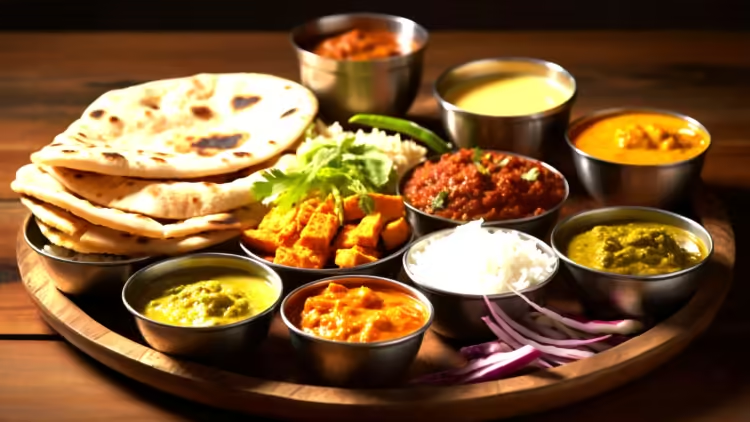
Posted by Reviewtale
- Jan 26, 2025
- 756
- 0
What is Thali? A Traditional Indian Meal on One Plate
India, a land of diverse cultures and rich culinary traditions, is renowned for its vibrant and elaborate meals. Among the many traditional dining experiences, one that stands out is the Thali.
But what is Thali? A Thali is not just a meal; it is a beautifully curated platter that brings together a variety of dishes, offering a perfect balance of flavors, textures, and nutrients. Typically served on a large plate or banana leaf, a Thali consists of multiple components, including rice, breads, lentils, vegetables, curries, pickles, chutneys, and desserts. This wholesome and satisfying meal represents the essence of Indian hospitality, where every bite tells a story of regional spices, seasonal ingredients, and centuries-old cooking traditions. Whether it’s a North Indian Thali rich in creamy gravies and breads or a South Indian Thali featuring rice, sambhar, and coconut-based dishes, this culinary tradition continues to be a cherished part of India’s food culture.
A Thali is a well-balanced meal served on a large plate or banana leaf, featuring a selection of dishes that represent the culinary essence of a particular region. It typically includes a mix of staple foods such as rice or roti, dal (lentils), sabzi (vegetable curry), raita (yogurt-based side), chutneys, pickles, papad, and desserts. The combination of sweet, spicy, tangy, and savoury flavours in a single meal makes the Thali a wholesome and satisfying dining option.



Regional Variations of Thali
India’s rich and diverse culinary heritage is a reflection of its varied geography, climate, and cultural influences. Each region has distinct cooking styles, ingredients, and flavours that have evolved over centuries. These regional cuisines not only cater to the local palate but also hold immense popularity across the country, influenced by lifestyle, climate, and agricultural availability. Below is a deeper exploration of India’s major regional food choices:
North Indian Cuisine: A Rich and Hearty Indulgence
Encompassing states like Punjab, Haryana, Delhi, Uttar Pradesh, Uttarakhand, Himachal Pradesh, and Jammu & Kashmir, North Indian cuisine is known for its bold flavours, creamy gravies, and wheat-based staples. Due to the colder climate in northern states, the food is often rich, high in calories, and generously spiced to provide warmth and sustenance. Dairy products like ghee, butter, and paneer play a prominent role.
Thali Includes: Paneer Butter Masala – A creamy, tomato-based paneer dish; Dal Makhani – Slow-cooked black lentils simmered with butter and cream; Aloo Gobi – A flavourful potato and cauliflower stir-fry; Naan & Jeera Rice – Accompaniments that enhance the richness of curries; Curd & Salad – A cooling addition to balance the meal; Gulab Jamun & Kheer – Traditional desserts loved across generations
Why Popular?
The love for North Indian food stems from its comforting and filling nature, making it a preferred choice in celebrations, weddings, and daily meals.
South Indian Cuisine: A Light, Rice-Based Delight
Spread across Tamil Nadu, Kerala, Karnataka, Andhra Pradesh, and Telangana, South Indian cuisine primarily revolves around rice, lentils, and coconut, influenced by the warm and humid tropical climate. The dishes are often light, fermented, and rich in probiotics, making them highly digestible and ideal for the region’s climate.
Thali Includes: Sambar & Rasam – Tangy lentil-based stews packed with spices; Poriyal – Stir-fried seasonal vegetables with mustard and coconut; Curd Rice – A cooling dish perfect for warm climates; Dosa & Idli – Fermented rice and lentil dishes, served with chutneys; Payasam – A sweet pudding made with rice or vermicelli and jaggery
Why Popular?
With its nutritious, gluten-free, and probiotic-rich meals, South Indian cuisine is a preferred choice for both health-conscious individuals and those seeking comfort food.
Gujarati Cuisine: A Balance of Sweet and Savory
From the vibrant state of Gujarat, this cuisine is known for its subtle sweetness, even in savory dishes. The semi-arid climate of Gujarat has shaped its food culture, with a preference for dry, long-lasting foods and an extensive use of pulses and yogurt to maintain nutrition in a relatively dry landscape.
Thali Includes: Dhokla – A steamed, fermented snack made from chickpea flour; Dal & Kadhi – Lentil-based dishes with a sweet-and-sour flavour; Thepla – A spiced flatbread made with fenugreek leaves; Undhiyu – A mixed vegetable dish cooked with winter vegetables; Shrikhand – A sweetened yogurt dessert, often flavoured with saffron and cardamom; Pickles & Chutneys – Essential accompaniments to enhance flavours
Why Popular?
Gujarati food is well-balanced, combining nutrition and taste, and its variety of vegetarian dishes make it a favourite among plant-based food lovers.
Rajasthani Cuisine: A Bold and Flavourful Affair
Hailing from Rajasthan, this cuisine is a result of the state’s arid climate, leading to a preference for dried lentils, grains, and dairy-based dishes that can be preserved for longer durations. The cuisine is rich in spices and flavours due to the scarcity of fresh vegetables.
Thali Includes: Dal Baati Churma – A classic Rajasthani meal of wheat dumplings, lentils, and a sweet accompaniment; Gatte Ki Sabzi – Chickpea flour dumplings in a spicy yogurt gravy; Ker Sangri – A tangy dish made with dried berries and beans, suited for desert climates; Missi Roti – A spiced gram flour flatbread; Ghewar – A festival favourite sweet made from flour and sugar syrup
Why Popular?
The robust flavours and long shelf-life of Rajasthani dishes make them ideal for travel and feasts, ensuring they remain a favourite choice in Indian households.
Bengali Cuisine: A Seafood and Rice Extravaganza
Bengali cuisine, from West Bengal and parts of Tripura and Assam, is deeply influenced by the abundance of rivers and fertile lands. Rice and fish dominate the diet, with mustard oil and aromatic spices adding distinct flavours. Due to the humid climate, lightly spiced and easily digestible dishes are preferred.
Thali Includes: Fish Curry – The staple dish, often cooked with mustard sauce; Shukto – A mildly bitter mixed vegetable dish; Dal & Rice – Essential elements of every Bengali meal; Mishti Doi – A sweetened yogurt specialty; Sandesh – A soft, melt-in-the-mouth dessert made from chhena (cottage cheese)
Why Popular?
Bengali food is loved for its delicate balance of flavours and emphasis on fresh ingredients, making it a top choice for seafood lovers.
Maharashtrian Cuisine: A Spicy and Diverse Treat
Spanning across Maharashtra, this cuisine varies from the coastal Konkan specialties to the spicy flavours of Vidarbha. The warm and tropical climate has led to a preference for tangy, spicy, and coconut-based dishes.
Thali Includes: Varan Bhaat – A simple and nutritious lentil-rice combination; Puran Poli – A festive sweet flatbread filled with jaggery and lentils; Bhakri – A coarse millet bread served with curries; Usal – A sprouted lentil curry, rich in proteins; Thecha – A fiery green chili and garlic chutney; Aamras – Sweet mango pulp, a seasonal delicacy
Why Popular?
With its perfect blend of spice, tanginess, and seasonal ingredients, Maharashtrian food appeals to a broad spectrum of palates, from mild to fiery.
India’s diverse culinary landscape offers an endless variety of flavours, textures, and aromas, deeply rooted in regional traditions, climates, and agricultural practices. Whether it’s the rich gravies of the North, the fermented delights of the South, or the sweet-savoury balance of the West, each cuisine tells a story of its region’s unique heritage and lifestyle.
What is Thali and Why is it So Popular in India?
Thali is a traditional Indian meal that offers a well-rounded dining experience by bringing together a variety of dishes on a single plate. It is popular across India due to its rich flavours, nutritional value, and cultural significance. Here’s why thali continues to be a favourite choice among food lovers:
Variety in One Plate
One of the biggest reasons behind the popularity of thali in India is the diverse combination of dishes it includes. A typical thali consists of different flavours—spicy, tangy, sweet, and savoury—ensuring a satisfying meal that caters to all taste preferences in one sitting.
Nutritional Balance
A well-prepared thali is not just delicious but also highly nutritious. It includes a balanced mix of lentils (dal), vegetables, dairy products (curd, paneer), grains (rice, roti), and sweets, making it a wholesome meal that provides essential nutrients to the body.
Cultural Representation
Thali is more than just food; it represents the culinary heritage of different regions in India. Whether it’s a North Indian thali with rich curries and bread or a South Indian thali with rice, sambar, and coconut-based dishes, each variation reflects the unique flavours of its origin.
Affordable and Satisfying
Many restaurants and eateries across India offer thalis at reasonable prices, making them an economical choice for a fulfilling meal. Whether in a high-end restaurant or a local dhaba, thali remains an accessible option for people from all walks of life.
A Symbol of Tradition and Hospitality
Thali holds a special place in Indian culture and traditions. It is often served during festivals, weddings, and religious ceremonies, symbolizing abundance and hospitality. The concept of serving food on a large plate with multiple items also emphasizes the Indian tradition of sharing and togetherness.
In conclusion, what is thali? It is a complete meal that not only satisfies hunger but also reflects India’s diverse food culture. With its balance of flavours, nutrition, and tradition, thali continues to be a beloved choice for food lovers across the country.
Merits of Thali for Customers: Why It’s a Great Meal Choice
If you have ever wondered what is thali, it is a traditional Indian meal served on a single platter, consisting of a variety of dishes that together create a wholesome and satisfying dining experience. Thali is immensely popular among food lovers due to its affordability, nutritional value, and diverse flavours. Here’s why customers love choosing a thali meal:
Cost-Effective Meal Option
One of the biggest advantages of ordering a thali is its affordability. It provides a complete meal at a reasonable price, making it a budget-friendly option for individuals and families. Instead of ordering multiple à la carte dishes, customers get a well-balanced meal in a single serving, making thali a cost-effective and value-for-money choice.
A Burst of Diverse Flavors
A thali is a treat for the taste buds as it includes multiple dishes with different flavours—sweet, spicy, tangy, and savoury—ensuring a satisfying experience for every palate. Whether it’s the comforting dal, crispy papad, aromatic curries, or a refreshing dessert, each element in a thali adds to its delightful variety. This makes it an ideal choice for those who love exploring different flavours in one meal.
A Wholesome and Balanced Meal
When it comes to nutrition, thali is an excellent choice as it provides a well-rounded combination of essential nutrients. Typically, a thali includes:
- Proteins from lentils, legumes, and dairy items like paneer or curd
- Carbohydrates from rice and roti
- Vitamins and Minerals from a variety of cooked and raw vegetables
- Healthy Fats from ghee or oils used in cooking
- Sweets or Fruits that complete the meal with a touch of indulgence
This balance ensures that customers receive all the necessary nutrients in a single meal, making thali a healthy dining option.
A Fulfilling and Satisfying Experience
Thali meals are often served in generous portions, making them highly fulfilling. Many restaurants even offer unlimited thalis, where customers can enjoy refills of their favourite dishes, ensuring they leave fully satisfied. This unlimited serving concept adds to the appeal, especially for those with a hearty appetite.
It is now clear what thali is, without a doubt. It is more than just a meal—it is an experience that combines affordability, flavour, nutrition, and satisfaction in one plate. Whether you’re craving a variety of flavours, looking for a nutritious meal, or simply want a fulfilling dining experience without breaking the bank, thali is the perfect choice for food lovers.
What is Thali and Its Merits for Restaurant Owners?
If you are in the restaurant business, you might be wondering, what is thali, and why is it a great addition to your menu? Thali is a traditional Indian meal that offers a well-balanced combination of dishes served on a single platter. It is not only popular among customers for its variety and affordability but also highly beneficial for restaurant owners. Here’s how serving thali can help improve your business operations and profitability:
Efficient Kitchen Operations
One of the major advantages of offering thali is that it helps streamline kitchen efficiency. Since thalis follow a set menu with pre-decided dishes, restaurants can:
- Optimize ingredient usage by planning bulk preparation, reducing food waste.
- Improve workflow as chefs can focus on cooking large portions rather than preparing individual à la carte orders.
- Reduce wait times by assembling meals quickly, ensuring smooth service during peak hours.
This structured approach allows for better cost control and maximized use of resources, making thali an efficient and profitable meal option.
Enhanced Customer Retention and Loyalty
Thali is widely loved for its affordability and variety, making it a go-to choice for regular diners. Since it offers a fulfilling meal at a reasonable price, customers are more likely to return for repeat visits.
- Regular customers help create a steady revenue stream.
- Satisfied customers lead to positive word-of-mouth marketing, attracting new diners.
- Affordable meal options encourage family and group dining, boosting footfall.
By offering an enjoyable and budget-friendly dining experience, thali can help restaurants build a loyal customer base.
Faster Table Turnover and Increased Revenue
One of the biggest challenges for restaurants is managing table occupancy efficiently. Since thali meals are pre-plated and ready to serve, they significantly reduce service time.
- Customers can be served quickly, leading to faster table turnover.
- More customers served in less time means higher daily revenue potential.
- Limited decision-making speeds up ordering, reducing the burden on waitstaff.
For restaurants looking to maximize their seating capacity and earnings, thali is an excellent choice to improve efficiency without compromising customer satisfaction.
A Powerful Marketing Opportunity
In the age of digital dining, presentation matters. Thali is not only delicious but also visually appealing, making it highly shareable on social media platforms.
- A beautifully arranged thali can attract food bloggers and influencers, increasing online visibility.
- Instagrammable meals encourage customers to post and tag the restaurant, leading to organic promotion.
- Special thali offerings (such as festive thalis, unlimited thalis, or regional specialty thalis) can create buzz and excitement among food lovers.
Leveraging the aesthetic appeal of thali can help restaurants enhance their brand presence and attract more foot traffic.
What is thali? It is not just a meal but a strategic business asset for restaurant owners. From improving kitchen efficiency and customer retention to boosting revenue and marketing potential, serving thali can significantly contribute to a restaurant’s success. By incorporating thali into the menu, restaurants can cater to a wide audience while maintaining cost-effective and efficient operations.
How Can a Restaurant Owner Market Thalis Effectively?
Thali is not just a meal—it’s an experience that attracts food lovers with its variety, taste, and nutritional balance. If you are a restaurant owner looking to promote this traditional Indian platter, effective marketing strategies can help you boost visibility, attract more customers, and increase sales. But first, what is thali? It is a well-balanced meal served on a single platter, featuring multiple dishes that provide a mix of flavours and essential nutrients. To make your thali offerings stand out, consider these proven marketing techniques:
- Leverage Social Media Promotion
Social media platforms like Instagram, Facebook, and TikTok are powerful tools for showcasing thalis.
- Post high-quality images and videos of your thali platters, emphasizing their variety and vibrant presentation.
- Create engaging Reels and Stories showing the preparation process, plating, or customer reviews.
- Use popular food hashtags like #IndianThali, #Foodie, and #AuthenticThali to reach a wider audience.
- Encourage diners to share their experience and tag your restaurant for organic promotion.
- Offer Special Discounts and Deals
Introducing limited-time offers and exclusive deals can help drive customer interest and sales.
- Weekday Lunch Deals: Attract office-goers and students with discounted lunchtime thalis.
- Festive Promotions: Serve special thalis during Indian festivals like Diwali, Navratri, or Pongal.
- Unlimited Thali Offers: Provide unlimited refills at a fixed price to entice customers looking for a fulfilling meal.
- Organize Food Challenges
Hosting engaging eating challenges can create excitement and encourage customer participation.
- Introduce a Jumbo Thali Challenge, where customers try to finish a massive platter within a set time to win a reward.
- Offer free meals or discounts to challenge winners, motivating others to participate.
- Promote the event through live videos and customer testimonials to generate buzz.
- Collaborate with Food Influencers & Bloggers
Partnering with food bloggers, YouTubers, and Instagram influencers can boost your restaurant’s visibility.
- Invite local influencers to taste and review your thali, sharing their experience with their followers.
- Offer exclusive tasting events or discounts for influencers who help promote your brand.
- Encourage influencers to create engaging content, such as food vlogs, reviews, or behind-the-scenes kitchen tours.
- Provide Customization Options
Customers appreciate flexibility in their meals, and offering customizable thalis can help attract a wider audience.
- Allow diners to choose their preferred dishes, such as selecting between different curries, rice types, or desserts.
- Introduce diet-specific thalis, such as vegan, gluten-free, or high-protein variations.
- Offer regional specialty thalis like Rajasthani, Bengali, or South Indian platters to cater to diverse tastes.
- List Thalis on Food Delivery Platforms
Ensuring that your thali meals are available for online ordering can significantly boost sales.
- Partner with popular food delivery apps like Swiggy, Zomato, or Uber Eats.
- Create attractive combo deals to make online thalis more appealing.
- Offer free delivery or discounts on bulk orders to encourage repeat customers.
- Launch Seasonal & Festival Specials
Introducing festive and seasonal thali menus can help attract food enthusiasts during cultural celebrations.
- Offer Navratri fasting thalis, Diwali special platters, or Eid-themed meals.
- Use seasonal ingredients to create limited-edition thalis that highlight fresh flavors.
- Promote these special thalis with banners, social media ads, and festive-themed content.
What is thali? It is a diverse, flavorful, and satisfying meal that appeals to a wide range of customers. By implementing creative marketing strategies such as social media promotion, influencer collaborations, food challenges, and special deals, restaurant owners can successfully attract more diners and increase thali sales.
The Rise of Thali in Restaurants
Over the years, Thali restaurants have gained immense popularity, with many eateries specializing exclusively in serving elaborate Thali meals. Famous restaurant chains such as 6 Ballygunge Place, oh calcutta!, and Bhojohori Manna, are a few names offering authentic Bengali Thalis. Whereas the restaurant like, Panchavati Gaurav offers authentic Rajasthani and Gujarati Thalis, while numerous South Indian restaurants serve traditional banana leaf Thalis. The unlimited Thali concept, where diners can enjoy refills of their favourite dishes, has further fueled its appeal.
Conclusion
Thali is more than just a meal; it is a celebration of India’s rich culinary heritage, offering a perfect blend of flavors, nutrition, and cultural significance. Its popularity continues to grow, making it a staple in both traditional and modern dining experiences. The popularity of lunchbox meals and thalis is rising, with kanse ki thali emerging as a trending choice. For restaurant owners, serving Thali presents an excellent opportunity to attract customers, enhance brand identity, and boost sales.
At Review Tale, we are passionate about exploring and reviewing the best dining experiences. If you own a restaurant that serves an exceptional Thali, we would love to feature your story! Visit Review Tale to get your restaurant listed and connect with food lovers seeking authentic and delicious meals.
Fequently Asked Questions (FAQs)
1. What is Thali?
Thali is a traditional Indian meal served on a single platter, consisting of a variety of dishes, including rice, bread, lentils, vegetables, curries, pickles, and desserts. It offers a balanced mix of flavors and nutrients, making it a wholesome and satisfying dining experience.
What is thali used for in India?
In India, thali is used for serving a complete and balanced meal that represents the diverse culinary traditions of different regions. It is commonly enjoyed in homes, restaurants, and special occasions like weddings, festivals, and religious ceremonies. Thali offers a mix of flavors and nutrients in one platter, making it a wholesome and satisfying dining experience.
Item #3
Recommended Posts
- Feb 1, 2025
- 351 read
How Behind-the-Scenes Food Content Boosts Visibility & Engagement Table of ContentsIntroductionThe Power...
Read Article- Jan 29, 2025
- 322 read
7 Effective Ways to Use Customer Reviews to Build Trust Table of...
Read Article- Jan 18, 2025
- 501 read
Unforgettable Dining Experiences: How a Unique Selling Proposition Can Elevate Your Restaurant...
Read Article- Jan 16, 2025
- 1252 read
What Unique Aspects of Your Restaurant, Cloud Kitchen, or Café Set You...
Read Article- Jan 12, 2025
- 660 read
How to Remove Negative Reviews From Google? Negative reviews on Google can...
Read Article- Jan 3, 2025
- 344 read
Table of Contents IntroductionThe Origins of Fast FoodNutritional Myths and RealitiesConvenience vs....
Read Article- Dec 25, 2024
- 345 read
6 Essential Steps for Restaurants: Masterfully Choose the Right Target Customers Choosing...
Read Article- Nov 16, 2024
- 318 read
Tips and Tricks to Optimize Your Restaurant Profile: Improve Your Online Visibility...
Read Article









3 comments
Customer Engagement: 10 Tricks for Best Dishes & Drinks
5 Hidden Gems in Regional Indian Cuisines Beyond Butter Chicken and Biryani
Er PARAMANANDA BHANJA
April 17, 2025 9:23 amA beautiful column about Restaurant and its varieties of THALIS where many dishes are available.